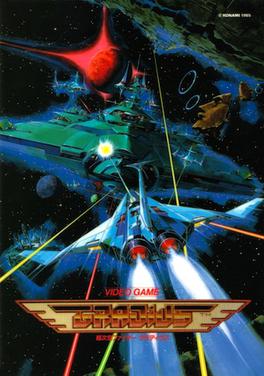
Gradius is a side-scrolling shooter video game developed and published by Konami. The first game in the Gradius series, it was originally released as a coin-operated arcade game in 1985. The player maneuvers a spacecraft known as the Vic Viper that must defend itself from the various alien enemies. The game uses a power-up system called the "power meter", based upon collecting capsules to purchase additional weapons.

R-Type is a horizontally scrolling shooter arcade video game developed and released by Irem in 1987 and the first game in the R-Type series. The player controls a star ship, the R-9 "Arrowhead", in its efforts to destroy the Bydo, a powerful alien race bent on wiping out all of mankind. The R-9 can acquire a glowing orbicular device called a "Force", protecting it from enemy fire and providing additional firepower. The arcade version was distributed by Nintendo in North America; it is the last arcade title Nintendo distributed.
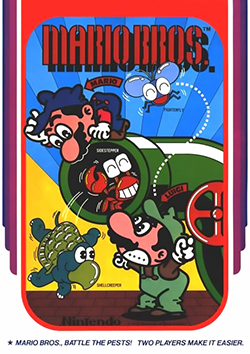
Mario Bros. is a platform game developed and published by Nintendo as an arcade video game in 1983. It was designed by Shigeru Miyamoto and Gunpei Yokoi, Nintendo's chief engineer. Italian twin brother plumbers Mario and Luigi exterminate creatures emerging from the sewers by knocking them upside-down and kicking them away. The Famicom/Nintendo Entertainment System version is the first game produced by Intelligent Systems. It is part of the Mario franchise, but originally began as a spin-off from the Donkey Kong series.

Hudson Soft Co., Ltd. was a Japanese video game company that released numerous games for video game consoles, home computers and mobile phones, mainly from the 1980s to the 2000s. It was headquartered in the Midtown Tower in Tokyo, with an additional office in the Hudson Building in Sapporo.

Balloon Fight is an action video game developed by Nintendo and HAL Laboratory and published by Nintendo. The original arcade version was released for the Nintendo VS. System internationally as Vs. Balloon Fight, while its Nintendo Entertainment System counterpart was released in Japan in 1985 and internationally in 1986.

Kung-Fu Master, known as Spartan X in Japan, is a side-scrolling beat 'em up game developed by Irem as an arcade game in 1984, and distributed by Data East in North America. Designed by Takashi Nishiyama, the game was based on Hong Kong martial arts films. It is a loose adaptation of the Jackie Chan, Sammo Hung, and Yuen Biao film Wheels on Meals (1984), called Spartan X in Japan, with the protagonist Thomas named after Jackie Chan's character in the film. The game is also heavily inspired by the Bruce Lee film Game of Death (1972), which was the basis for the game's concept. Nishiyama, who had previously designed the side-scrolling shooter Moon Patrol (1982), combined fighting elements with a shoot 'em up gameplay rhythm. Irem and Data East exported the game to the West without the Spartan X license.

Hogan's Alley is a light gun shooter video game developed and published by Nintendo. It was released for the Family Computer in 1984 and then the arcade Nintendo VS. System and Nintendo Entertainment System in 1985. It was one of the first hit video games to use a light gun as an input device, along with Nintendo's Duck Hunt (1984). The game presents players with "cardboard cut-outs" of gangsters and innocent civilians. The player must shoot the gangs and spare the innocent people. It was a major arcade hit in the United States and Europe.

Tennis is a sports video game developed by Nintendo in 1983, and released for the Family Computer (Famicom) in 1984. The arcade game version Vs. Tennis was also released for the Nintendo VS. System in 1984, becoming a hit at Japanese and American arcades that year; it was the sixth top-performing arcade game of 1984 in the United States. Tennis is one of 17 launch games for the Nintendo Entertainment System (NES) in North America and Europe. The game was re-released for the Game Boy as a launch game in North America.
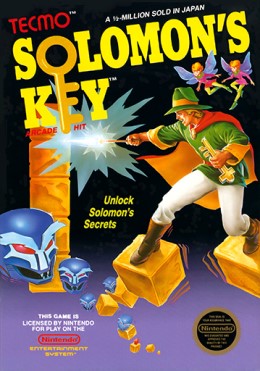
Solomon's Key is a puzzle game developed by Tecmo in 1986 for an arcade release on custom hardware based on the Z80 chipset. It was ported to multiple systems including the Nintendo Entertainment System and Commodore 64. The PC Engine version was known as Zipang and the Game Boy version as Solomon's Club. A prequel, Solomon's Key 2, was released in 1992 for the NES. The game was also ported to Virtual Console for the Nintendo 3DS and Wii U in 2006 and later to Nintendo Switch Online in 2018.

Bomberman is a maze video game developed and published by Hudson Soft. The original home computer game Bomber Man was released in July 1983 for the NEC PC-8801, NEC PC-6001 mkII, Fujitsu FM-7, Sharp MZ-700, Sharp MZ-2000, Sharp X1 and MSX in Japan, and a graphically modified version for the MSX and ZX Spectrum in Europe as Eric and the Floaters. A sequel, 3-D Bomberman, was produced. In 1985, Bomberman was released for the Nintendo Entertainment System. It spawned the Bomberman series with many installments building on its basic gameplay.

Rygar is a side-scrolling platform game created by Tecmo in 1986 and originally released for arcades in Japan as Argos no Senshi. The player assumes the role of a "Legendary Warrior", battling through a hostile landscape. The main feature of gameplay is the use of a weapon called the "Diskarmor", a shield with a long chain attached to it.
The Virtual Console is a line of downloadable video games for Nintendo's Wii and Wii U home video game consoles and the Nintendo 3DS family of systems.

Contra is a video game series produced by Konami composed primarily of run and gun-style shooting games. The series debuted in February 1987 with the Japanese coin-operated arcade game of the same name, which was has since spawned several sequels produced for various platforms.

Earth Defense Force is a 1991 horizontal scrolling shooter video game developed and published by Jaleco. Originally an arcade game, the game was later released for the Super Nintendo Entertainment System as Super Earth Defense Force, dropping the two-player cooperative gaming mode while adding graphics and selectable weapons. The SNES version was released in Japan on October 25, 1991, and in North America in January 1992. The SNES version was eventually released on the Wii Virtual Console in Europe on October 29, 2010, in Japan on January 11, 2011, and in North America on July 14, 2011. It is included in Nintendo Switch SNES Online as of September 5, 2019.
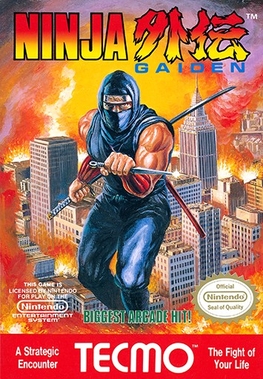
Ninja Gaiden, released in Japan as Ninja Ryūkenden and as Shadow Warriors in Europe, is an action-platform video game developed and published by Tecmo for the Nintendo Entertainment System. Its development and release coincided with the beat 'em up arcade version of the same name. It was released in December 1988 in Japan, in March 1989 in North America, and in August 1991 in Europe. It has been ported to several other platforms, including the PC Engine, the Super NES, and mobile phones.
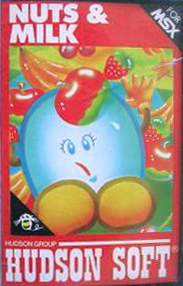
Nuts & Milk is a puzzle-platform game developed and published by Japanese software developer Hudson Soft in 1983. The game was released for the FM-7, MSX, NEC PC-8801, NEC PC-6001, and later to the Famicom in Japan. Along with Lode Runner, it was the first third-party video game to be released on a Nintendo console.
Star Soldier is a series of scrolling shooters mainly developed by Hudson Soft. Konami has owned the rights to the series since their absorption of Hudson Soft in 2012. The first game, named Star Soldier, appeared on the MSX and NES in 1986, and the series has continued on various gaming systems. Star Soldier itself has received enhanced remakes for both the GameCube and PlayStation 2 in 2003, and a different remake for the PlayStation Portable in 2005, while the latest installment of the series was released on the Wii as a WiiWare game in 2008. In addition, Super Star Soldier, Final Soldier, Soldier Blade and Star Parodier have been re-released on the Wii's Virtual Console and on the Japanese PC Engine's Best Collection lineup for the PSP. The Star Soldier games are best known for their distinctive music, unique weapon power-ups, and a special time attack high score mode called "Caravan Mode".
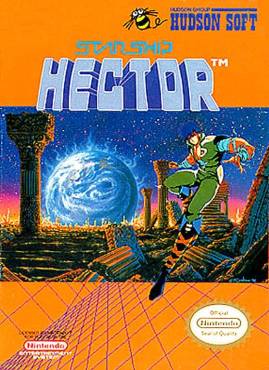
Starship Hector, originally released as Hector'87 (ヘクター'87), is a scrolling shooter developed and published by Hudson Soft for the Nintendo Entertainment System. The game contains both horizontally and vertically scrolling segments. The player's starship has two modes of fire: one to tackle flying enemies and one for ground-based ones.

Star Soldier is a shoot 'em up video game developed and published by Hudson Soft for the Nintendo Entertainment System and the MSX. The player pilots the starship "Caesar", travelling through space stations occupied by powerful supercomputers known as "Starbrains" who threaten the galactic empire. Star Soldier greatly resembles the earlier arcade game Star Force.

Super Contra, known as Super Contra: The Alien Strikes Back in Japan and Probotector II: Return of the Evil Forces in Europe, is a run and gun video game by Konami, originally released as a coin-operated arcade video game in December 1987. It is the sequel to the original Contra and part of the Contra series. The game stars Bill Rizer and Lance Bean as they are sent to thwart another alien invasion from the vicious Red Falcon.



















